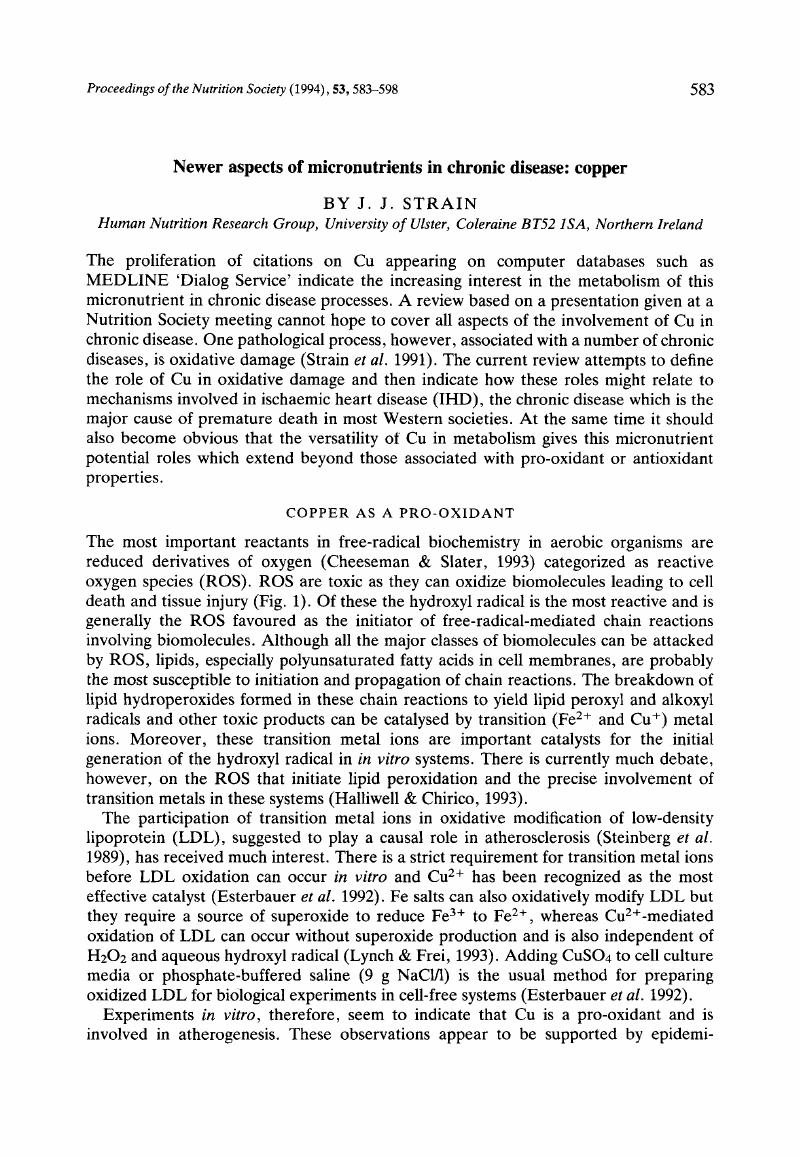Crossref Citations
This article has been cited by the following publications. This list is generated based on data provided by Crossref.
Russo, C.
Olivieri, O.
Girelli, D.
Azzini, M.
Guarini, P.
Stanzial, A. M.
Friso, S.
Pasqualini, R.
and
Corrocher, R.
1996.
Therapeutic Uses of Trace Elements.
p.
207.
Turley, E.
McKeown, A.
Harvey, L.
Fairweather‐Tait, S.J.
Crews, H.M.
and
Strain, J.J.
1997.
Assessing copper status ‐ a review.
Nutrition & Food Science,
Vol. 97,
Issue. 6,
p.
229.
1998.
Abstracts of Communications.
Proceedings of the Nutrition Society,
Vol. 57,
Issue. 01,
p.
1A.
Root, Martin M
Hu, Jifan
Stephenson, Lani S
Parker, Robert S
and
Campbell, T.Colin
1999.
Determinants of plasma retinol concentrations of middle-aged women in rural China.
Nutrition,
Vol. 15,
Issue. 2,
p.
101.
Millo, Hadas
and
Werman, Moshe J
2000.
Hepatic fructose-metabolizing enzymes and related metabolites: role of dietary copper and gender.
The Journal of Nutritional Biochemistry,
Vol. 11,
Issue. 7-8,
p.
374.
Lauridsen, Charlotte
Jensen, Søren Krogh
Skibsted, Leif H
and
Bertelsen, Grete
2000.
Influence of supranutritional vitamin E and copper on α-tocopherol deposition and susceptibility to lipid oxidation of porcine membranal fractions of M. Psoas major and M. Longissimus dorsi.
Meat Science,
Vol. 54,
Issue. 4,
p.
377.
Frank, Adrian
Sell, David R.
Danielsson, Rolf
Fogarty, John F.
and
Monnier, Vincent M.
2000.
A syndrome of molybdenosis, copper deficiency, and type 2 diabetes in the moose population of south-west Sweden.
Science of The Total Environment,
Vol. 249,
Issue. 1-3,
p.
123.
Milne, David B.
2000.
Clinical Nutrition of the Essential Trace Elements and Minerals.
p.
69.
Feillet-Coudray, C.
Coudray, C.
Bayle, D.
Rock, E.
Rayssiguier, Y.
and
Mazur, A.
2000.
Response of diamine oxidase and other plasma copper biomarkers to various dietary copper intakes in the rat and evaluation of copper absorption with a stable isotope.
British Journal of Nutrition,
Vol. 83,
Issue. 5,
p.
561.
Turley, Eithne
McKeown, Andrea
Bonham, Maxine P.
O’Connor, Jacqueline M.
Chopra, Mridula
Harvey, Linda J.
Majsak-Newman, Gosia
Fairweather-Tait, Susan J.
Bügel, Susanne
Sandström, Brittmarie
Rock, Edmond
Mazur, Andrzej
Rayssiguier, Yves
and
Strain, J.J.
2000.
Copper supplementation in humans does not affect the susceptibility of low density lipoprotein to in vitro induced oxidation (FOODCUE project).
Free Radical Biology and Medicine,
Vol. 29,
Issue. 11,
p.
1129.
Skrivanová, V
Skrivan, M.
Marounek, M.
and
Baran, M.
2001.
Effect of feeding supplemental copper on performance, fatty acid profile and on cholesterol contents and oxidative stability of meat of rabbits.
Archiv für Tierernaehrung,
Vol. 54,
Issue. 4,
p.
329.
McAnena, L.B.
and
O'Connor, J.M.
2002.
The Nutrition Handbook for Food Processors.
p.
117.
Schümann, K
Classen, HG
Dieter, HH
König, J
Multhaup, G
Rükgauer, M
Summer, KH
Bernhardt, J
and
Biesalski, HK
2002.
Hohenheim Consensus Workshop: Copper.
European Journal of Clinical Nutrition,
Vol. 56,
Issue. 6,
p.
469.
Strain, J. J.
2002.
Trace Elements in Man and Animals 10.
p.
923.
O’Connor, J. M.
Bonham, M. P.
Turley, E.
Kehoe, C.
Coulter, J. S.
Faughnan, M. S.
McKeown, A.
McKelvey-Martin, V. J.
Rock, E.
Rayssiguier, Y.
Mazur, A.
Flynn, A.
Cashman, K.
Baker, A.
and
Strain, J. J.
2002.
Trace Elements in Man and Animals 10.
p.
943.
Kim, Soo Yeon
Kim, Jae Wook
Ko, Young Sook
Koo, Jee Eun
Chung, Hae Yeon
and
Lee-Kim, Yang Cha
2003.
Changes in Lipid Peroxidation and Antioxidant Trace Elements in Serum of Women With Cervical Intraepithelial Neoplasia and Invasive Cancer.
Nutrition and Cancer,
Vol. 47,
Issue. 2,
p.
126.
Lenartowicz, M.
Kowal, M.
Buda‐Lewandowska, D.
and
Styrna, J.
2003.
Pathological structure of the kidney from adult mice with mosaic mutation.
Journal of Inherited Metabolic Disease,
Vol. 25,
Issue. 8,
p.
647.
Uriu-Adams, Janet Y.
and
Keen, Carl L.
2005.
Copper, oxidative stress, and human health.
Molecular Aspects of Medicine,
Vol. 26,
Issue. 4-5,
p.
268.
Bügel, Susanne
Harper, Angela
Rock, Edmond
O'Connor, Jacqueline M.
Bonham, Maxine P.
and
Strain, J. J.
2005.
Effect of copper supplementation on indices of copper status and certain CVD risk markers in young healthy women.
British Journal of Nutrition,
Vol. 94,
Issue. 2,
p.
231.
Kapil, Umesh
and
Singh, Preeti
2005.
Serum Copper Levels among a Tribal Population in Jharkhand State, India: A Pilot Survey.
Food and Nutrition Bulletin,
Vol. 26,
Issue. 3,
p.
309.



